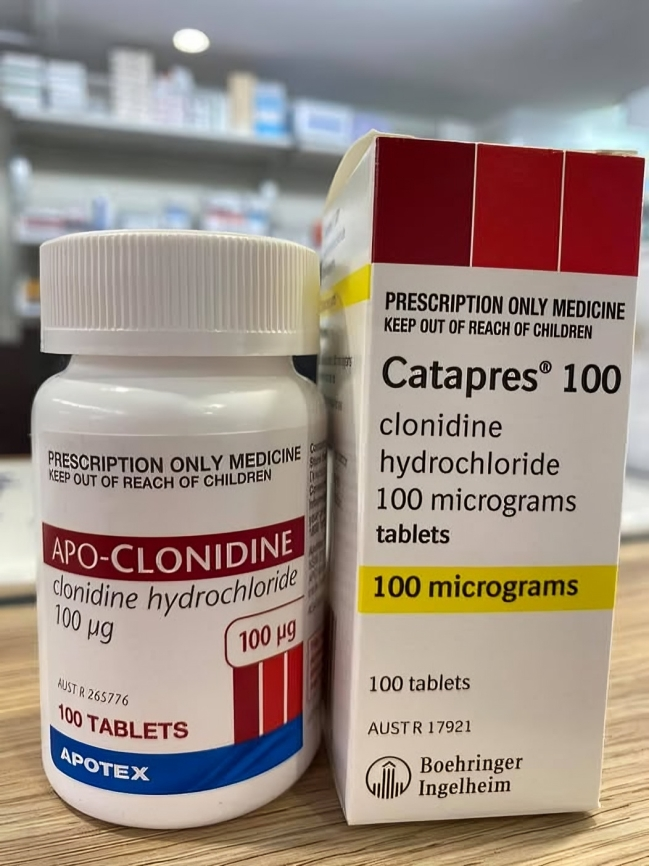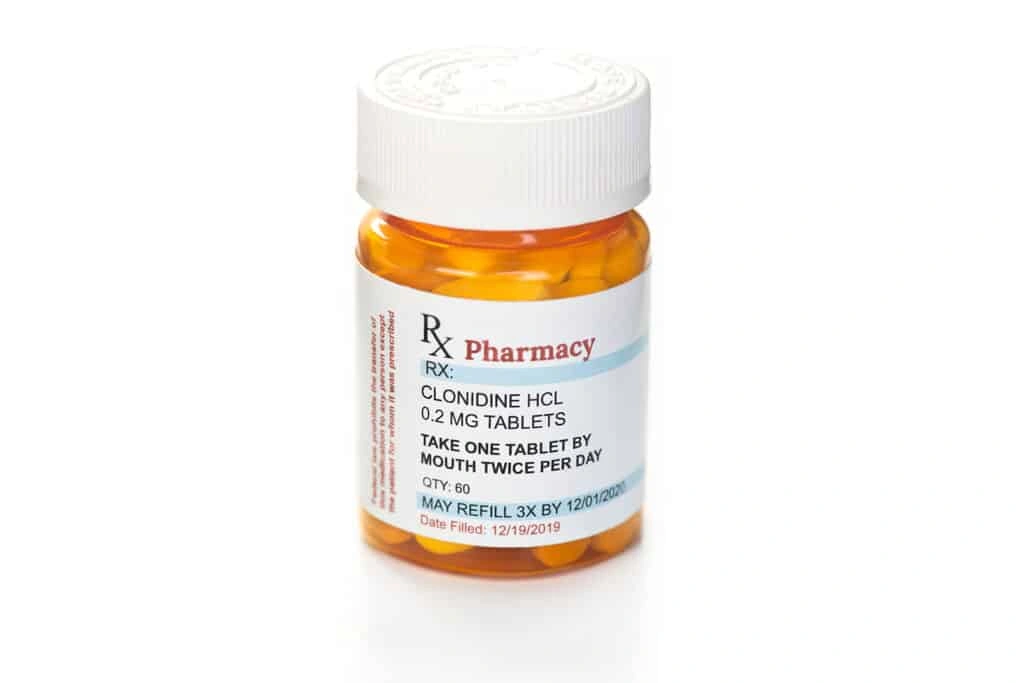Clonidine is a medication with a range of uses. It is primarily prescribed for high blood pressure. However, it also has off-label uses for conditions like ADHD and anxiety.
Despite its benefits, clonidine is not without risks. Misuse of this drug can lead to serious health issues. Some people mistakenly believe clonidine can produce a high.
This misconception can lead to dangerous misuse. Clonidine works by affecting the brain’s receptors, reducing nervous system activity. This can result in sedation, but not a typical high.
Understanding clonidine’s effects is crucial for safe use. It can cause side effects like drowsiness and dry mouth. More serious effects include low blood pressure and heart rate.
Clonidine’s interactions with other drugs can also pose risks. Combining it with alcohol or other depressants can enhance sedative effects. This increases the risk of overdose.
For those using clonidine, proper dosage and monitoring are essential. This is especially true for children, who may experience different side effects. Always consult a healthcare provider before making any changes to clonidine use.
What Is Clonidine? An Overview
Clonidine is a medication with a diverse therapeutic profile. Initially developed to manage high blood pressure, its uses have expanded. Today, it serves in various clinical settings beyond its original purpose.
The drug belongs to a class known as alpha-2 adrenergic agonists. By targeting specific receptors in the brain, clonidine reduces sympathetic outflow. This results in lowered blood pressure and a calming effect on the nervous system.
Clonidine is typically available in oral tablet form. It is also offered as a transdermal patch for continuous delivery. This versatility allows for tailored treatment plans to suit individual needs.
Key Points About Clonidine:
- Primary Use: Hypertension
- Additional Uses: ADHD, anxiety
- Forms: Oral tablets, transdermal patches
Given its complex mechanisms, clonidine requires careful usage. It’s crucial to follow a doctor’s guidance to avoid adverse effects. Misuse can quickly lead to complications.
Despite its benefits, clonidine isn’t without risks. Potential side effects range from mild to severe. Proper monitoring and adherence to prescribed regimens are vital for safety.
Understanding clonidine’s role in treatment can help patients better manage their conditions. It’s an effective tool when used correctly, offering relief for many ailments. Always consult healthcare professionals for tailored advice.
How Clonidine Works in the Body
Clonidine’s mechanism hinges on its action in the brain. It specifically targets alpha-2 adrenergic receptors. By doing so, it diminishes the activity of the sympathetic nervous system.
This reduction in sympathetic activity has several effects. Primarily, it lowers heart rate and blood pressure. These changes are beneficial for patients with hypertension.
Additionally, clonidine calms the nervous system. This property makes it useful in treating anxiety and withdrawal symptoms. Its sedative effects can also aid in sleep-related issues.
Clonidine’s Mechanisms of Action:
- Targets: Alpha-2 adrenergic receptors
- Reduces: Sympathetic nervous system activity
- Effects: Lowers heart rate and blood pressure
However, the widespread impact on the nervous system requires caution. Patients must carefully adhere to prescribed dosages to prevent side effects. The body adjusts to clonidine, so sudden discontinuation can pose risks.
Prolonged use can lead to dependence. This is why gradual tapering under medical supervision is recommended. Health professionals offer tailored plans to minimize withdrawal symptoms.
Overall, clonidine’s function in the body is multifaceted. Its primary action on receptors affords both therapeutic and sedative benefits. These diverse effects make it a valuable, albeit powerful, medication.
Approved and Off-Label Clonidine Uses
Clonidine has several approved uses beyond its primary role in managing high blood pressure. It has gained recognition for its versatility in treating different medical conditions.
One of its notable uses is in ADHD management. Though not a first-choice medication for ADHD, it aids in reducing hyperactivity and impulsivity. This makes it a valuable addition to treatment strategies.
Clonidine is also used to ease anxiety. It calms overactive nerves, which helps in managing symptoms associated with anxiety disorders. These calming effects extend to those undergoing withdrawal from opioids.
In the realm of sleep, clonidine offers sedative benefits. Patients with insomnia related to hyperarousal can find it advantageous. Its effects in this area should be monitored closely.
Clonidine’s Uses at a Glance:
- Approved Uses: Hypertension
- Off-Label Uses: ADHD, anxiety, withdrawal symptoms, insomnia
Despite these benefits, clonidine is not without its challenges. The potential for side effects necessitates careful oversight by healthcare providers. It’s vital for users to follow prescribed dosages accurately to prevent complications.
Healthcare providers sometimes employ clonidine in unique scenarios. Its role in treating symptoms of other medications can be a significant advantage. Clonidine can also be combined with other treatments for enhanced efficacy.
Still, clonidine’s administration demands caution due to its far-reaching effects on the body. Users should engage in frequent consultations with their healthcare provider to manage and adjust its use safely.
Clonidine for ADHD: How and Why It’s Used
Clonidine offers distinct advantages when prescribed for ADHD. It functions by moderating hyperactive behaviors and impulsivity. This effect adds value to the treatment regimens of both children and adults with ADHD.
Doctors typically prescribe clonidine as a supplement to other ADHD medications. When combined, the effects can be more comprehensive and beneficial. It helps in the overall management of ADHD symptoms.
This medication acts on the brain’s adrenergic receptors. By targeting these receptors, clonidine alters neurotransmitter release. This alteration helps in stabilizing mood and behavior, crucial for managing ADHD symptoms.
Benefits of Clonidine in ADHD:
- Reduces: Hyperactivity and impulsivity
- Supports: Combined therapy with other ADHD medications
- Stabilizes: Mood and behavior
Nonetheless, monitoring is essential when using clonidine in ADHD treatment. Side effects may still occur, affecting the daily functioning of the individual. Users should discuss potential side effects openly with their healthcare providers.
Prescriptions for children require particularly careful consideration. Dosage and response need continuous assessment to ensure safety. Parents and caregivers play a pivotal role in noting any behavioral or physical changes.
Understanding when and why clonidine is used for ADHD can be eye-opening. It sheds light on the intricate balance healthcare professionals maintain with treatment plans. These insights emphasize clonidine’s role as part of a broader management strategy.
Clonidine for Anxiety: Evidence and Practice

When it comes to anxiety, clonidine’s calming effects are central. Its ability to reduce physiological symptoms makes it valuable for anxiety management. This benefit stems from its impact on the autonomic nervous system.
Clonidine reduces heightened arousal states by lowering heart rate and blood pressure. Such effects can ease the body’s acute stress response, thus benefiting those with anxiety disorders.
How Clonidine Assists with Anxiety:
- Reduces: Heart rate and blood pressure
- Calms: Autonomic nervous system
- Eases: Stress response
Evidence supports clonidine’s effectiveness in specific types of anxiety. Studies highlight its role in minimizing symptoms related to social and generalized anxiety disorders. Nonetheless, clonidine is not typically a first-line treatment for anxiety.
In practice, clonidine is often used when other treatments fall short. Healthcare professionals may suggest its use as an adjunct or alternative therapy. Its benefits, however, must be weighed against potential side effects.
Patients considering clonidine for anxiety should engage in discussions with healthcare providers. They need to address the suitability and individualized response to the medication. Tailored treatment plans ensure that the therapeutic benefits outweigh the risks.
Overall, clonidine’s use in anxiety showcases its flexibility. Yet, its application demands a cautious and informed approach. Understanding its potential can lead to more effective anxiety management.
Clonidine and Sleep: Can It Help Insomnia?
The sedative properties of clonidine naturally lend themselves to sleep aids. This makes it a consideration for individuals battling insomnia, particularly when linked to anxiety or hyperactivity. Clonidine helps promote tranquility, easing the transition into sleep.
Clonidine’s role in sleep improvement is tied to its ability to calm overactive physiological responses. By reducing nervous system excitability, clonidine can contribute to a more restful night’s sleep.
Clonidine’s Potential Benefits for Sleep:
- Promotes: Relaxation
- Reduces: Nervous system excitability
- Facilitates: Transition into sleep
Healthcare providers look at clonidine for sleep aid beyond its traditional use cases. Though it is not a primary sleep medication, its calming effects are often harnessed. They can be particularly beneficial when patients experience stress-related sleep disorders.
Consideration of clonidine for sleep does require attention to detail. Monitoring side effects is critical, as they can interrupt sleep. Patients should be advised on the best times to take clonidine to maximize its sedative effects and minimize disturbance.
Those using clonidine for sleep should maintain an open line of communication with their healthcare provider. Adjustments in dosage or timing may be necessary. Personalized plans ensure that clonidine’s benefits are optimized for the individual’s sleep needs.
Clonidine Effects: What to Expect
Clonidine is a multifaceted medication, affecting various physiological functions. Users can expect a range of effects, largely dependent on their individual health status and dosage.
Primarily, clonidine influences cardiovascular and nervous system activities. It decreases heart rate and dilates blood vessels, thus lowering blood pressure.
While effective, clonidine’s effects can sometimes be unexpected. Drowsiness and sedation are frequently reported outcomes, making it unsuitable for tasks requiring alertness.
Key Effects of Clonidine:
- Cardiovascular: Lowers blood pressure, decreases heart rate
- Neurological: Causes sedation, potential mood changes
Users should also anticipate potential effects on appetite and digestive processes. Some may experience changes in bowel habits or appetite fluctuations.
Clonidine’s influence on cognitive function cannot be overlooked. It might impair cognitive abilities or reaction times in some individuals.
It’s essential for patients to remain vigilant about any changes they experience. Regular communication with healthcare providers aids in managing these effects.
Understanding clonidine’s comprehensive impact allows patients to weigh its benefits against any adverse reactions. This informed perspective fosters better management.
Common Clonidine Side Effects
Clonidine, like many medications, can cause a range of side effects. These typically affect daily activities and are often manageable.
Dry mouth is a prevalent side effect. Many users report this temporary sensation, which usually subsides with time.
Drowsiness and fatigue often occur, leading to reduced energy levels. Adjusting activity schedules may help mitigate these symptoms.
Frequently Reported Side Effects:
- Drowsiness: Common and varies in intensity
- Dry Mouth: Manageable with hydration
Some patients experience mild constipation. Dietary changes and increased water intake typically alleviate this issue.
Additional effects include dizziness and lightheadedness. Taking clonidine at bedtime may lessen their impact.
Despite these common side effects, clonidine remains widely used. Patients should consult their healthcare provider for advice if symptoms become troublesome.
Overall, awareness and minor lifestyle adjustments can improve the clonidine experience. A proactive approach ensures side effects are managed effectively.
Serious and Rare Side Effects
While most clonidine side effects are mild, more severe reactions are possible. These require prompt medical attention.
Significant blood pressure drops can occur, leading to fainting spells or severe dizziness. Monitoring blood pressure regularly is crucial for safety.
Heart-related issues, such as bradycardia, are rare but serious. Clonidine users should be alert to heart rate changes.
Serious Effects to Monitor:
- Heart: Bradycardia, significant heart rate changes
- Blood Pressure: Severe drops can be dangerous
Less frequently, individuals may experience mental health changes. Depression or mood swings necessitate professional evaluation.
Patients should also watch for signs of allergic reactions. Rash, hives, or swelling warrant immediate medical intervention.
Although rare, high-risk symptoms should not be underestimated. Proactive communication with healthcare providers is essential in these cases.
Recognizing these serious side effects helps in preventing complications. Quick action is vital to ensure safe clonidine use.
Clonidine Side Effects in Children
Children using clonidine may experience a different side effect profile compared to adults. Their responses can be unique, warranting careful observation.
In pediatric cases, drowsiness is a common side effect. Caregivers should monitor sleep patterns to ensure adequate rest.
Changes in behavior, such as irritability or mood shifts, can also occur. Parents should maintain open communication with healthcare providers.
Pediatric Side Effects to Consider:
- Drowsiness: Affects daily routines
- Behavioral Changes: Irritability, mood swings
Some children may experience gastrointestinal symptoms, including constipation or abdominal discomfort. Managing diet and hydration helps mitigate these effects.
Growth and development are other areas to monitor. Regular check-ups can ensure clonidine does not adversely affect these parameters.
Given the sensitive nature of prescribing medication to children, parents should be fully informed. Understanding potential effects aids in effective management.
The importance of a tailored approach for pediatric clonidine use cannot be overemphasized. Individualized care ensures optimal outcomes for younger patients.
Can You Get High on Clonidine? The Facts About Misuse
Clonidine is not commonly associated with getting high. Yet, its misuse remains a concern.
The medication can induce sedation. This calming effect might appeal to those seeking a drug-induced state of relaxation.
Euphoria, although rare, can occur with misuse. However, this isn’t typical and comes with serious risks.
Possible Outcomes of Clonidine Misuse:
- Sedation: Leads to reduced alertness, impacts daily life
- Low Mood: Potential for mood swings and depression
Misuse poses significant health threats. These include dangerously low blood pressure and bradycardia.
Individuals at risk are often those with a history of substance misuse. Clonidine misuse is particularly hazardous for these populations.
It is vital to use clonidine as directed by healthcare providers. Avoiding self-medication prevents potential misuse.
Furthermore, understanding clonidine’s intended medical purposes helps mitigate the risk of misuse. Awareness is key.
Signs and Risks of Clonidine Misuse
Recognizing misuse signs is crucial. It ensures timely intervention and prevents severe health outcomes.
Initial signs may include increased drowsiness and lethargy. This differs from typical side effects due to its intensity.
Indicators of Clonidine Misuse:
- Intense Sedation: More pronounced than expected
- Behavioral Changes: Mood swings, irritability
Misuse risks extend to severe physical health issues. Dangerous drops in blood pressure and heart rate are primary concerns.
Cognitive functions can also be impaired. Users might face challenges with concentration and memory retention.
Family and friends should be aware of these signs. Prompt action can prevent escalation and ensure safety.
Education on misuse symptoms is instrumental in addressing these issues. It fosters a more proactive health approach.
Clonidine Overdose: Symptoms and Emergency Response
Clonidine overdose can pose life-threatening risks. Immediate medical attention is crucial in these scenarios.
Overdose signs commonly include profound drowsiness and severe lethargy. Extreme fatigue may set in quickly.
Symptoms of Clonidine Overdose:
- Extreme Drowsiness: Severely impaired alertness
- Bradycardia: Dangerously slow heart rate
Additional overdose symptoms involve respiration difficulties. Breathing might become shallow or irregular.
Users may experience significant drops in blood pressure. This can lead to fainting or lightheadedness.
Emergency Response Tips:
- Call Emergency Services: Immediate professional help is vital
- Monitor Vital Signs: Keep track of heart rate and breathing
As clonidine overdose is serious, acting swiftly can save lives. The availability of quick-response actions is crucial.
Educating potential users and caregivers about these symptoms is vital. It ensures preparedness and effective emergency management.
Understanding these risks enhances patient safety and leads to better health outcomes. Awareness is the first line of defense against overdose.
Clonidine Interactions: What You Need to Know

Clonidine interacts with various medications, which can heighten its effects. Understanding these interactions is vital for safe use.
Patients must disclose all current medications to their healthcare provider. This list includes prescription drugs, over-the-counter medications, and supplements.
Potential Interactions:
- Antidepressants: Can enhance sedative effects
- Blood Pressure Medications: Risk of excessive blood pressure drop
Combining clonidine with other drugs impacting the central nervous system can cause increased sedation. This interaction affects cognitive functions and alertness.
Key Considerations:
- Consultation: Regularly discuss medication changes with your doctor
- Monitoring: Watch for unexpected side effects
Healthcare providers often adjust dosages to mitigate interaction risks. Personalized treatment plans are essential to optimizing therapeutic outcomes.
Clonidine and Other Medications
Clonidine’s therapeutic efficacy and safety may be compromised by interactions with other medications. These interactions can be subtle or significant.
Concurrently taking clonidine with central nervous system depressants may enhance sedative effects. This can lead to exaggerated drowsiness or impaired function.
Common Medication Interactions:
- Beta-Blockers: Can lead to reduced heart rate
- Diuretics: Potential for increased blood pressure lowering
Antihypertensive drugs, when combined with clonidine, can cause an excessive drop in blood pressure. Monitoring blood pressure is critical in such cases.
Another concern is the impact on heart rate. Clonidine combined with heart-rate-lowering drugs requires vigilance due to potential bradycardia.
Understanding these interactions supports better management of potential side effects and enhances the effectiveness of treatment plans.
Patients should always inform their healthcare providers about all medications they are taking. Complete information is crucial for safe treatment management.
Clonidine and Alcohol or Recreational Drugs
Clonidine combined with alcohol or recreational drugs can result in severe sedative effects. The risk of overdose and other adverse effects increases significantly.
Interaction Consequences:
- Enhanced Sedation: Increased drowsiness and cognitive impairment
- Respiratory Depression: Dangerously slow breathing
Use of alcohol with clonidine can lead to significant loss of motor control. This combination may impair decision-making abilities and increase accident risks.
Clonidine paired with recreational drugs also poses substantial health threats. Central nervous system depressants can multiply each other’s effects, leading to dangerous outcomes.
The potential for overdose is high with such combinations. Awareness and avoidance of this interaction are critical for patient safety.
Knowledge of these interactions promotes informed decisions and ensures safer medication use. Open communication with healthcare providers is essential for optimizing treatment approaches.
Safe Use: Dosage, Administration, and Monitoring
Clonidine dosage is crucial for both effectiveness and safety. It must be tailored to individual needs based on medical history and condition severity.
Healthcare providers initiate treatment with the lowest possible dose, gradually adjusting to minimize side effects. Regular follow-ups are vital to monitor response and adjust as needed.
For oral tablets, it’s essential to take them consistently, at the same time each day. This helps maintain stable medication levels in the body.
Proper Administration:
- Follow prescribed schedules strictly
- Do not crush or chew tablets
- Monitor for side effects routinely
Monitoring is an ongoing process. Patients should regularly check blood pressure and heart rate, as clonidine affects these parameters directly.
Any sudden changes or unusual symptoms should be reported to a healthcare provider promptly. Such communication aids in early detection of adverse effects or interactions.
Over time, individual responses to clonidine may change. Regular consultations ensure adaptations in treatment are made when necessary.
Clonidine Patches vs. Oral Tablets

Clonidine comes in different forms, including patches and oral tablets. Each has unique benefits and considerations.
Comparison Factors:
- Convenience: Patches are changed weekly, while tablets are taken daily.
- Consistency: Patches offer a steady release, reducing peak concentration fluctuations.
Patches can be beneficial for those with routine difficulties or forgetfulness, as they require less frequent management. Oral tablets might be preferred for those who need more immediate dose adjustments.
Lifestyle and patient preference often influence the choice between patches and tablets. Some patients may find patches more convenient in terms of daily routines.
Healthcare providers discuss these options with patients, considering lifestyle, preferences, and medical history before making recommendations. Individualized care ensures the best outcomes.
What to Do If You Miss a Dose or Need to Stop
Missing a dose of clonidine can disrupt treatment, but careful management helps mitigate this.
If a dose is missed, take it as soon as remembered unless it’s almost time for the next dose. Never double up on doses to compensate for a missed one.
Steps to Consider:
- Take missed dose immediately if not close to next dose
- Avoid doubling doses
- Consult healthcare provider if unsure
When stopping clonidine, it should not be done abruptly. A gradual tapering off is necessary to prevent withdrawal symptoms, like rebound hypertension.
It’s critical to follow a doctor’s guidance when discontinuing treatment. This ensures a safe transition and minimizes health risks.
Adhering to these practices promotes effective management of clonidine treatment. Open communication with healthcare providers supports safety in dosing and discontinuation scenarios.
Special Considerations for Children and Adolescents
Using clonidine in children and adolescents requires particular care. Young patients may experience different effects and require tailored dosing.
Behavioral and developmental factors are crucial in clonidine administration for younger patients. It’s often used for ADHD or anxiety, but with special precautions.
Key Considerations:
- Dosage: Often lower than adult doses; must be personalized.
- Side Effects: Children might experience increased sedation or mood changes.
- Monitoring: More frequent checkups to observe both efficacy and side effects.
Healthcare providers closely monitor these patients for any behavioral changes. Parents should be attentive to mood, focus, or sleep disruptions, and report concerns promptly.
Understanding potential side effects is crucial for caregivers. Educating families about symptoms like dry mouth or dizziness can help manage expectations and reduce anxiety.
Strategies for Safe Use:
- Create a consistent medication schedule
- Engage children in understanding their treatment
- Encourage open communication between caregivers and healthcare providers
Adolescents benefit from being part of their healthcare discussions. Involving them can foster responsibility and ensure adherence to treatment plans.
When managed well, clonidine can significantly improve quality of life for children and adolescents. Supporting young patients with education and guidance is essential for success.
Clonidine Withdrawal: Symptoms and Prevention
Stopping clonidine suddenly can trigger withdrawal symptoms. This often includes rebound hypertension, anxiety, and agitation.
Gradual tapering is the safest way to reduce withdrawal risks. Healthcare providers usually recommend decreasing the dose slowly.
Withdrawal Symptoms to Watch For:
- Rebound Hypertension: Sudden spike in blood pressure.
- Anxiety and Restlessness: Increased nervousness.
- Headaches and Nausea: Physical discomfort as the body adjusts.
Patients may also experience difficulty sleeping and fast heart rates. These symptoms usually require medical oversight for safe management.
Healthcare providers typically devise individualized withdrawal plans. Monitoring during this process can help catch and address symptoms early.
Educating patients on potential withdrawal effects can empower them to seek help immediately. Open communication with healthcare providers is key.
Gradual cessation of clonidine under professional guidance ensures safety. Patients should never attempt to stop clonidine on their own.
Monitoring and Managing Side Effects
Monitoring side effects of clonidine is essential for maintaining safety. Both patients and healthcare providers play a role in this process.
Patients should regularly check their blood pressure and heart rate. This helps detect any unusual changes early.
Common Side Effects to Monitor:
- Drowsiness: Feeling overly sleepy during the day.
- Dry Mouth: Persistent dryness and thirst.
- Constipation: Difficulty with bowel movements.
Education on managing these side effects can improve comfort. For instance, staying hydrated can alleviate dry mouth.
In case of more severe side effects, immediate medical attention might be necessary. These include extreme drowsiness, slow heart rate, or fainting.
Management Strategies:
- Hydration: Increases saliva production for dry mouth.
- Dietary Changes: Fiber intake can ease constipation.
- Rest: Helps manage drowsiness symptoms effectively.
For children, parents should monitor for behavioral changes. These may signal side effects needing adjustments in treatment.
Regular follow-ups with healthcare providers ensure ongoing evaluation. They also provide an opportunity to adjust dosages as needed.
Frequently Asked Questions About Clonidine
Patients and caregivers often have questions about clonidine. Here, we address some common concerns to provide clarity and guidance.
What Are the Main Uses of Clonidine?
Clonidine is primarily used for hypertension. However, it also finds use in managing ADHD and anxiety symptoms.
Can Clonidine Be Used for Anxiety?
Yes, clonidine can calm the nervous system. It reduces the physiological symptoms associated with anxiety disorders.
Is Clonidine Safe for Children?
Clonidine is prescribed for children, especially those with ADHD. However, it requires careful monitoring and dosage adjustments.
List of Possible Side Effects:
- Common: Drowsiness, dry mouth, constipation.
- Serious: Very low heart rate, severe dizziness.
What Should Be Avoided While Taking Clonidine?
Avoid alcohol and certain medications that depress the nervous system. These can enhance sedative effects and pose risks.
How Does Clonidine Affect Sleep?
Clonidine can help improve sleep due to its sedative properties. But it should be used under medical supervision for sleep issues.
Key Interactions to Consider:
- With Other Drugs: Antidepressants and some blood pressure medications.
- With Substances: Alcohol and recreational drugs.
For personalized advice, always consult a healthcare provider. They can offer guidance specific to individual health needs and circumstances.
Key Takeaways and Final Thoughts
Understanding clonidine is crucial for safe and effective use. Its primary role is in managing blood pressure, but it also has diverse applications.
Patients should adhere to medical guidance. Misuse can lead to adverse effects, making proper use vital.
Important Points to Remember:
- Versatile Uses: Beyond blood pressure, helpful for ADHD and anxiety.
- Potential Risks: Misuse and interactions pose dangers.
- Monitoring: Regular follow-ups ensure safety and efficacy.
Children prescribed clonidine require careful supervision. Their physiological responses can differ significantly from adults.
Ultimately, clonidine remains a valuable tool in managing various conditions. Educated use under professional care maximizes its benefits while minimizing risks. Always seek advice from healthcare providers to ensure the best outcomes for health and wellness.



